#they in fact are very much not and are norse pagan
Explore tagged Tumblr posts
Text
The Person of Interest, previously known as "The Guy" before finding out they are also genderqueer and uses they/them exclusively, just sent me a voice message and the nerves are nerving, why am i nervous to open a voice message 🙃
#kee speaks#i dont remember if i talked about that conversation#i'd been anxious to bring up the gender thing cause i didn't know where they stood on that#considering we met while working at a christian summer camp and they attended two christian colleges near me#so we were both very in that situation when we met so i was anxious that maybe they still had that mind set#and the fear that they'd react badly upon me coming out#but i finally broached the topic by just asking 'a weird question but are you still xtian?' lol#they in fact are very much not and are norse pagan#and they mentioned some gender exploration as they left xtianity so we were able to get into that#it's honestly wild how similar our lives have been cause our marriages lasted about the same amount of time and we divorced at the same tim#left xtianity around the same time and discovered our gender queerness/sexual queerness around the same time#it's wild#but we've been chatting on and off and sending reels back and forth on instagram#but today i was cleaning out my car in order to sell it (got my new truck yesterday~) and I found a pin i made at camp#with my 'camp name' on it and i'm like 80% sure that this person was the one who gave me that camp name so i sent a pic of it to them#and they sent a voice message in reply and I'm anxious to open it now lol#I'm wondering if it's going to be them yelling that name the way they would when they'd see me across the dinner hall lmao
3 notes
·
View notes
Text


Disclaimer: I'm not telling you how to 'correctly' practice your religion. This post is meant to make you think about whether the way you currently practice is based on a conscious choice or an unconscious bias. You are the only person who gets to decide what you believe in and how you live your life.
I will use norse polytheism as an example in this post, but it applies to other religions as well.

Polytheistic online spaces are becoming more and more monotheistic.
We have many Gods and Goddesses. We have the Landvættir (spirits of the land), Elves and Dwarfs and many more beings in our mythology. Yet, the vast majority of people who have accounts dedicated to norse paganism, mainly post about one, rarely more than 5 of them.
Loki, Odin, Thor, Freyja, Fenrir.
Those are the top contenders.

- Why is that?
I believe it has to do with the fact that most of us grew up in a monotheistic society. Even if your family isn't religious, I'm sure you've learned about christianity/islam/judaism through the people around you. There are churches/mosques/synagogues in your town, created to honor one god.
The holidays the people celebrate are centered around one god.
Politicians, movies, friends and neighbors, they all talk about their relationship with one god.
We simply never learned how polytheism can look in practice.
Now, don't get me wrong. I'm not saying that monotheism is somehow bad or worse than polytheism. We should all live alongside and learn from each other. What I am saying is, most of us don't have any idea how to focus on all these beings at once. It seems impossible to have a relationship with all of them. How much time would you have to spend on praying and preparing offerings? How long would it take to have a conversation with each of them at least once a week?
The answer is: too long. That's why this is not what you should be doing, if you're not trying to burn yourself out.
A little effort in relevant situations is enough.

- Why should I change anything if it's working for me?
Because each God and Spirit has their place and specialty.
Would you ask your dentist to fix your broken leg? Or a cook if they can remodel your house?
They are very capable at a certain thing, and maybe your house wouldn't look awful after the remodeling, but don't you think a construction worker and an interior decorator would've done a better job?
I think it's important to let each of them do what they're best at.

- How do I do that?
A little goes a long way.
Ask Iðunn for help, if you feel like there's no life left in you.
Thank Njöðr for the warm spring breeze.
Be good to a stray cat in honor of Freyja.
Leave a handmade flower crown or a bit of fruit outside for the spirits of the land.
Give the dwarfs a coin in exchange for some help with a crafting project.
Read stories from mythology or listen to them as an audiobook. Familiarize yourself with what each of those beings stand for, what they are associated with and what they like.
You will never find a perfect balance between all of them, and it's natural to have a closer relationship with some Gods/Spirits than others. But still, it is absolutely worth getting out of your comfort zone.

That is all from me for now. Good luck and happy worshipping! <3


Click here to get to my Etsy Shop!

#witchcraft#paganism#witchblr#witch#witches of tumblr#norse pagan witch#pagan#baby witch#pagan witch#norse paganism#norse pantheon#norse mythology#norse heathen#heathen#heathenry#polytheism#hellenism#hellenic pagan#kemetism#celtic paganism#celtic polytheism#celtic pagan#kemetic paganism
117 notes
·
View notes
Text
What Non-Pagans Need to Know About Fiction Featuring Pagan Gods

In light of Marvel's Loki show dropping a second season and a new Percy Jackson series on the horizon, I want to say some things about how fandom spaces can be respectful of real-life pagan religion.
Let's get one thing out of the way: literally no one is saying you can't enjoy fiction that uses pagan gods and heroes as characters. No one is saying, "Stop writing stories about our gods." In fact, many ancient cultures wrote fiction about their gods -- look at Greek theater or the Norse Eddas. The act of writing fiction about the gods is not offensive in itself.
But please remember that this is someone's religion.
The gods are not "just archetypes." Their myths are not "just stories." Their personalities are not a matter of artistic interpretation. For many pagans, the gods are very much real in a literal sense. I don't think Thor is a metaphor or a symbol -- for me, Thor is a real, autonomous spiritual being who exists outside of human perceptions of him, and who I have chosen to build a relationship with. Even if you are a hardcore atheist, I would hope you could at least be respectful of the fact that, to many modern pagans, the gods are both very real and very important.
When authors are not respectful of this fact, they reduce the gods, these very real objects of worship, to fictional characters. And here's the thing about fictional characters: they are fundamentally tools for authors to use to draw a desired emotional response from an audience.
Dracula's personality and behavior is wildly different depending on who is writing him, because different authors use Dracula to create different reactions in their audiences. In the 1931 film starring Bela Lugosi, he's equal parts alluring and disturbing, a symbol of America's mixed desire and disdain for foreigners. In Nosferatu, he's more strictly frightening and disgusting. In Francis Ford Coppola's movie, he's a tragic, romantic figure clinging to the last scraps of his humanity. In Netflix's Castlevania, he's an incredibly powerful being who has grown bitter and apathetic in his immortality. All of this is Dracula, and all of it is fine, because Dracula is not and never has been a central figure in anyone's religion.
Let's take a look at what happens when authors give this same treatment to real gods:
In Hellenic polytheism, Apollo is one of the most beloved gods, both historically and today. Apollo loves humanity, and humanity loves him back. He is the god of sunlight and of medicine, but also of poetry and song. He is one of humanity's most consistent defenders when one of the other gods gets wrathful. And while he does have dangerous or wrathful aspects of his own (he's also the god of disease, after all), he's also kind and soft with humanity in a way other gods often aren't, at least in some historic sources.
In the Lore Olympus comic series, Apollo is a villain. He's characterized as an abuser, a manipulator, and a violent man child. LO!Apollo is downright hateful, because the author wants us to hate him. Lore Olympus is a retelling of a myth about an abduction and forced marriage. Lore Olympus is also a romance. In order to get the audience to sympathize with Hades and root for his relationship with Persephone, Rachel Smythe needed to make someone else the villain. Apollo is the most obvious and extreme character assassination in Smythe's work, but several other gods (notably Demeter) also get the asshole makeover to tell the story Smythe wants to tell.
Here's where this becomes a problem: Hellenic polytheism is a fairly small religious community, while Lore Olympus is a massively popular webtoon with 1.3 billion views as of August 2023, print books available from major retailers, a TV adaptation in the works, and a very active online fandom. Rachel Smythe currently has a MUCH bigger platform than any Hellenic polytheism practitioner. Smythe and other authors are shaping how modern culture views the Hellenic gods, and that has a very real impact on their worshipers.
This means "Apollo is an abusive asshole" is becoming a popular take online, and is even creeping into pagan communities. I've personally seen people be harassed for worshiping Apollo because of it. I've seen new pagans and pagan-curious folks who totally misunderstand the roles Apollo, Hades, and Persephone play in the Hellenic pantheon because of Lore Olympus and other modern works of fiction.
There are tons of other examples of this in modern pop culture, but I'll just rattle off a few of the ones that annoy me most: Rick Riordan depicting Ares/Mars as a brutish asshole hyped up on toxic masculinity; Rick Riordan depicting Athena as a mother goddess; Marvel depicting Thor as a dumb jock; Marvel depicting Odin as a cold, uncaring father; DC depicting Ares as purely evil; whatever the fuck the Vikings TV show was trying to do with seidr; the list goes on.
All of these are examples of religious appropriation. Religious appropriation is when sacred symbols are taken out of their original religious context by outsiders, so that the original meaning is lost or changed. It requires a power imbalance -- the person taking the symbols is usually part of a dominant religious culture. In many cases, the person doing the appropriation has a much bigger platform than anyone who has the knowledge to correct them.
When Rick Rioridan or Rachel Smythe totally mischaracterizes a Greek god to tell a story, and then actual Hellenic pagans get harassed for worshiping that god, that's religious appropriation.
Religious appropriation is a real issue. This isn't just pagans being sensitive. To use an extreme example: Richard Wagner and other German Romantic authors in the 19th century used the Norse gods and other Germanic deities as symbols in their work, which was a major influence on Nazi philosophy. Without Wagner, the Nazis would not have latched onto the Norse gods as symbols of their white supremacist agenda. To this day, there are white supremacist groups who claim to worship our gods or who use our religious imagery in their hate movement. We are still reckoning with the misinterpretation of our gods popularized by Wagner and other German Romantics almost 200 years ago.
Again, no one is saying you can't enjoy fiction based on pagan mythology. But there are a few things you can do to help prevent religious appropriation in fandom spaces:
Above all else, be mindful that while this may just be a story to you, it is someone's religion.
Recognize that enjoying fiction based on our gods does not mean you know our gods. You know fictional characters with the same names as our gods, who may or may not be accurate to real-life worship.
Do not argue with or try to correct pagans when we talk about our experience of our gods.
Don't invalidate or belittle pagan worship. Again, this mostly comes down to recognizing that our religion is totally separate from your fandom. We aren't LARPing or playing pretend. Our sacred traditions are real and valid.
If you see other people in your fandom engaging in religious appropriation, point out what they are doing and why it isn't okay.
Please tag your fandom content appropriately on social media. Always tag the show, movie, book, etc. that a post is about in addition to other relevant tags. This allows pagans to block these fandom tags if we don't want to see them and prevents fandom content showing up in religious tags.
For example, if I'm posting about Athena from the Percy Jackson books, I would tag the post #athena #athenapjo #percyjackson #pjo. You get the idea.
And if fiction sparks your interest and you want to learn more about the actual worship of the gods, you can always ask! Most pagans love talking about our gods and trading book recs.
If you are writing fiction based on real mythology, talk to people who worship those gods. Ask them what a respectful portrayal would look like. If possible, include a note in your finished work reminding audiences that it is a work of fiction and not meant to accurately portray these gods.
#btw hades is also not a villain in helpol#this post is just mostly discussing how lo villiainizes apollo#shoutout to my roman pagan husband for proofreading and offering feedback#this post is Approved By The Council#psa#long post#paganism#pagan#paganblr#heathenry#norse heathen#norse paganism#inclusive heathenry#hellenic polytheism#helpol#religio romana#roman polytheism#roman pagan#marvel#mcu#loki series#loki season 2#percy jackson#percy jackson and the olympians#pjo#lore olympus#religious appropriation#my writing#white supremacy mention#white supremacy tw
462 notes
·
View notes
Text
Problematic and Bigoted Pagan Authors (and how to avoid them)
After what was pretty much a mess in a discord server I'm in over an author posting artwork containing Nazi symbols, I decided to make a post letting everyone know about certain authors and what to look out for. I will keep updating this list as I discover things!
Big thanks to @dvudushnydiaries for letting me know ab some Slavic Polytheist authors, as well as my friend Agnes for letting me know about some Irish Polytheist Authors too! <3
If you have any suggestions to add to this list, please let me know!!!
🛑 = Avoid as much as possible
⚠️ = Be very cautious around this author
Generally, here is some red flags to look out for:
Use of symbols associated with hate groups
Claims an (open culture) is closed via ethnicity, especially if these cultures or religions historically shared with other cultures.
Claims there is a "true" or "pure" version of a certain open religion.
Use of dogwhistles.
Writes historical inaccuracies, misinformation, appropriation, making up things and presenting them as fact, etc.
Refusal to take accountability for actions.
Any form of bigotry or discrimination
The list is under the cut!
Hellenic Polytheist Authors
🛑 Timothy Jay Alexander
creator of the "Pillars of Hellenismos", which have little historical basis.
Made homophobic and ableist remarks in a blog post, essentially saying that because ancient Greece did not allow same-sex marriage, that modern Hellenic Polytheists shouldn't too. In this same post he said that marriage should be for making a family, and that since LGBTQ+ people, as well as people with "physical deformities" either can not or should not have children, they cannot marry according to him.
The same ableist remarks listed above were used as reasoning as to why a disabled person shouldn't become a priest or priestess or any higher up positions due to not being in good health. This also reminds me of eugenics.
In that same blog post, referenced a group called YSEE, which is notorious for being homophobic, xenophobic, displaying nationalism among other things better explained in this post by @hellenic-reconstructionism
Books include: A Beginner��s Guide to Hellenismos - Hellenismos Today - The Gods of Reason: An Authentic Theology for Modern Hellenismos
🛑 Galina Krasskova
Numerous things have happened with this author, some of the most notable being selling "Bacchic Lives Matter" pins on Etsy during the 2020 Black Lives Matter movement protests, as well as defending a neo-nazi and fascist group, AFA, on a blog post
Some of her Hellenic Polytheist books include: Honoring the Mothers: Novenas to the Mothers of Our Gods and Heroes - Combatting the Evil Eye - Unto Herself: A Devotional Anthology for Independent Goddesses - Out of Arcadia: A Devotional Anthology in Honor of Pan - Guardian of the Road: A Devotional Anthology in Honor of Hermes
See Norse Polytheist section for her books on that.
🛑 Edward P. Butler
Supports Hindutva, which is Hindu fascism, antisemitic, as well as defends and supports Galina Krasskova.
Books include: Essays on a Polytheistic Philosophy of Religion - Essays on Hellenic Theology.
🛑 H. Jeremiah Lewis / Sannion
Neo-nazi, having nazi symbols on his blog. Also transphobic, islamophobic, and everything under the sun, really.
Books include: Ecstatic: For Dionysos - End to End - Everything Dances: Strange Spirits 3 - Gods and Mortals: New Stories of Hellenic Polytheism
Norse Polytheist Authors
🛑 Galina Krasskova
See Hellenic Polytheist section for details.
Her Norse Polytheist books include: Living Runes; Theory and Practice of Norse Divination - Northern Tradition for the Solitary Practitioner - Neolithic Shamanism; Spirit Work in the Norse Tradition
Irish Polytheist Authors
⚠️ Lora O'Brien
Has a cultish following, thier followers and even themselves bullying and publicly shaming other Irish Polytheists. Often acts negatively towards the Irish diaspora. Has taught Irish Catholic practices, which are closed.
Runs the Irish Pagan School, which has similar rhetoric.
Books include: Irish Witchcraft from an Irish Witch - A Practical Guide to Pagan Priesthood
Slavic Polytheist Authors
🛑 Patricia Woodruff
Has a cultish following, often writes wildly inaccurate information. In a recent book she had completely made up a deity whose name means "swastika". Rated her own books on Goodreads, and publicly responded to any reviews criticizing her books.
Books include: Woodruff's Guide to Slavic Deities - Roots of Slavic Magic Book 1: Slavic Deities & Their Worship
🛑 Madame Pamita
Recently had a (now-deleted) post with an artwork containing various Nazi symbols, and deleted any criticism and seemingly refused to take any accountability. In DM's had repeatedly alluded to if you didn't follow her you "didn't know anything about Slavic Polytheism". Said to be friends with Patricia Woodruff
Books include: The Book of Candle Magic, Baba Yaga's Book of Witchcraft
🛑 Dmitriy Kushnir
Writes about Rodnovery, which many Rodnovery groups in the US and other countries often have ethnonationalist and right-wing connotations and ideology.
Books include: Rodnover
⚠️ Natasha Helvin
Misconstrues Slavic culture to be Wiccan
Says witchcraft are the "universal laws of nature" and that subjects of karma and divine judgement are solely monotheistic.
Claims to be an initiated Haitian Vodou priestess, which is doubtful.
Kemetic Polytheist Authors
⚠️ E. A Wallis Budge
Inaccurate translations of texts
Books include: The Egyptian Book of the Dead (Translation)
#hellenic pagan#hellenic polytheism#psa#pagan#irish polytheism#slavic polytheism#kemetic polytheism#norse polytheism
89 notes
·
View notes
Note
Hey, I noticed that in one of your posts you showed an Iron Age Finnish woman's dress. Would you happen to have a good idea of what Finnish men were wearing in that era? The information on it seems sparse. I do have a relevant book that I'm about to look through, but I'd like to hear your insight too!
Hi! Thanks for the question (and sorry for the slow answer), I do love Finnish Iron Age clothing so it's always my pleasure to write about it. I've been wanting to do a deep dive into this for a long while, so maybe I'll do at some point a post about women's dress too.
Unfortunately no one has good idea of the Finnish Iron Age men's dress (and if you find any book or other source that claims otherwise, do not trust it), since there's much fewer archaeological finds of men's dress than women's dress. The most accepted theory on why the textiles of women's dress survived surprisingly well is because of the bronze ornamentation commonly sewn into especially the fine women's dresses of the era. The bronze protected them from decomposing fully. Presumably men's dresses were not decorated similarly then. There are some finds though and we can piece together at least some kind of vague picture.
I will be discussing the period from Viking Age to Crusade Age in Finland. Viking Age is often defined to cover 800s to mid-1000s and the Finnish Crusade Age started right after the Viking Age and ended in the end of 1200s, where the Finnish Medieval era begins. Crusade Age refers to the period where mostly Swedish (also German) crusaders in the span of couple of centuries conquered lands of the Baltic-Finnic pagans. The crusades of this period targeted pagans all over eastern Baltic Sea, including Baltic-Finnic Karelians, Livonians and Estonians, and Baltic peoples, and the Scandinavia too, where Sámi people were targeted. After that the Finland and Sápmi were colonized by Norse people and stayed that way untill Finland was transferred under Russian rule, but to this day Sápmi still stays under colonial rule, including Finnish colonial rule. The current Finland was very multicultural area, mostly populated by Finno-Ugric peoples, including Sámi people, Karelians and various Finnish peoples.
It's important to understand that even just Finnish peoples where not homogeneous, but had distinct, yet of course strongly related cultures. These were Finns (suomalaiset) (yes most people we now call Finns were not in fact called that) in the coast of southwestern and western Finland, Tavastians (hämäläiset) in central-western lake-Finland and Savonians (savolaiset) in central-eastern lake-Finland. This means we can't mix findings from all over Finland to reconstruct a dress without evidencing that all the elements were actually used in one place. These three tribes had broadly similar base for their clothes, but distinctive jewelry and detailing. The big divide was and has always been between eastern and western Finnish peoples. This is because western Finnish people were in close contact through the sea with Norse people and southern Baltic-Finnic peoples, while eastern Finnish people, Savonians mostly, were influenced a lot by their proximity with Karelians. Another dividing factor was the very different environmental conditions between western and eastern Finland. The Finnish coast especially in west is very flat and fertile land, while the lake area, especially in eastern Finland is very rocky, hilly and quite infertile. The main way it effected clothing differences was that western Finland being more wealthy had more elaborate clothing. Tavastians in both occasions fall quite in between, but they tended to be more in the western cultural camp.
My most important sources are a study by a doctor of cultural anthropology, Jenny Kangasvuo, Savon historia I (Savonian history) digitized and open sourced here and the digitized archeological collection of Finnish Heratage Agency. They are all in Finnish so not very useful for most people unfortunately.
Finnish Men's Dress in Viking and Crusader Ages
The basic garments men wore were broadly similar as women. They wore a shift/shirt, knee or above-knee length dress, cloak, belt, shoes and some kind of headwear. Wool was used most commonly, though the shirt would sometimes be linen too. Even evidence of silk has been found in some western Finland graves. I would assume that would be from a dress of some great man, who traveled to gain riches, possibly with vikings. Embroidery and decoration with metals was a typical feature of the whole Eastern Baltic Sea area. In Finland during this period bronze was the most common decorative metal, but silver was used too. Decorative elements were usually woven with small bronze spirals into all kinds of patterns. Here's examples from the reconstructed Ravattula's dress (Finns) used by women.
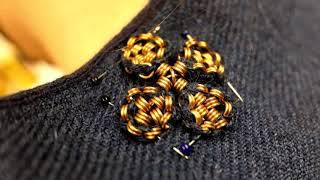
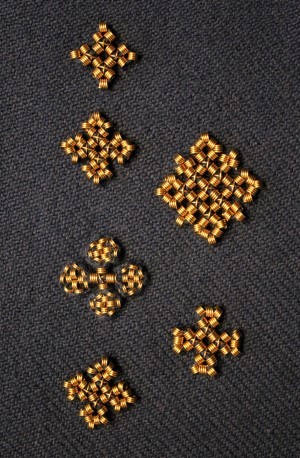
Shirt
The shirt (in Finnish shift of both women and men was called shirt) was basically a long shirt or under dress. We can assume it was similar to those of women's except shorter since the dress men wore was shorter too. They were made from wool or linen, I would assume wool was used in winter and linen in summer, when linen was even available. The neckline had a cut and closed with a bronze brooch. Horseshoe brooch was common. The first one is a quite typical bronze horseshoe brooch with a bit of ornamentation from Salo (Finns). The second one is from Tuukkala, (Savonians), it has exceptional ornate detailing and is uncommonly silver, not bronze. The third picture has two quite uniquely ornamented horseshoe brooches, first from Köyliö (Finns), second from Kurikka (Finns).
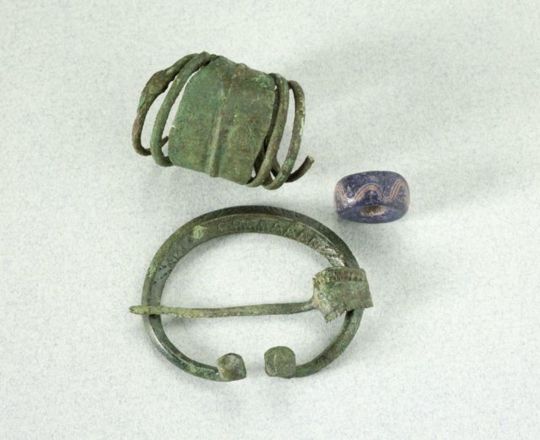


Legwear and footwear
Very little of men's legwear has survived and it's unclear weather men wore pants or separate pant legs, leg wraps or perhaps long socks. Evidence of strings decorated with bronze spirals and tablet woven band has been found in leg area of men's graves. This could mean that they wore either leg wraps, long sock or some sort of pant legs that needed to be secured with string or band under knee. Women used strings and tablet woven tape to secure leg wraps and socks, which I think supports that theory. Sometimes both bronze decorated string and tablet woven band was found in the leg area, which would still be explained by this theory, since it was common to decorate the ends of the bands with bronze decorated strings. Here's an example of sock bands just like that from the earlier mentioned reconstruction of the Ravattula's women's dress. Since men's dress was shorter, I think it would make sense if they still wore some kind of pants or separate pant legs with socks or leg wraps like that.

However, the strings and bands could have also been part of the shoes. Everyone probably wore similar shoes - laced leather shoes with a bit of pointed end. They might have been short or ankle length and the lacing was done with either leather cord or tablet woven band, which would also explain the findings. Socks or feet wraps would have been used in them, and straw or wool could be added as filling for warmth. Here's a pair of traditional Izhorian shoes from Estonia from early 1900s, and a pair of traditional Sámi shoes. The designs were likely roughly similar in Viking and Crusader Ages, though obviously more simple, and it's probable that Finnish shoes very something like that too. Here's a 1893 drawing of what findings of shoe material from Korpiselkä (Savonian or Karelian) might have looked like. Considering the quality of archaeology of that time, copious amounts of salt should be applied. And finally as a fourth picture there's reconstruction shoes from Ravattula's dress.
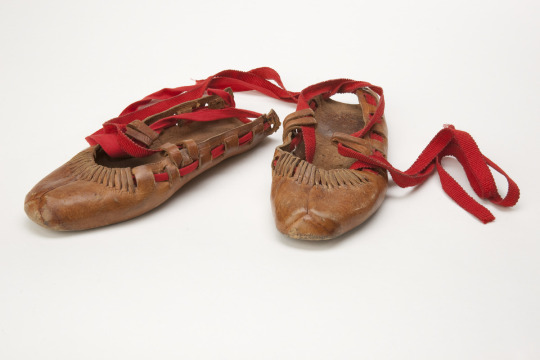
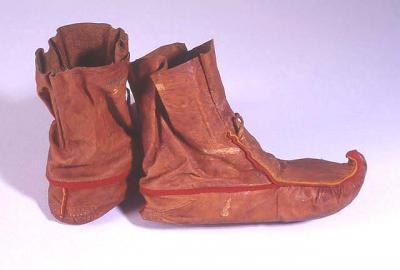
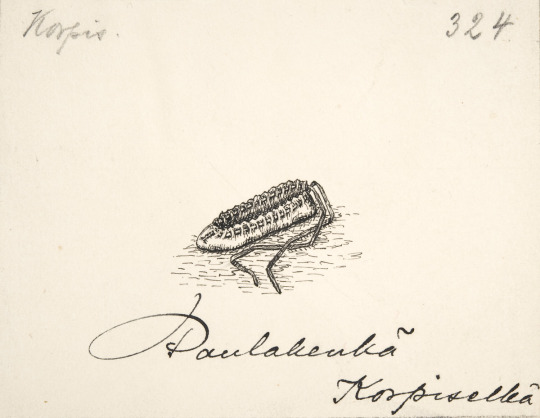
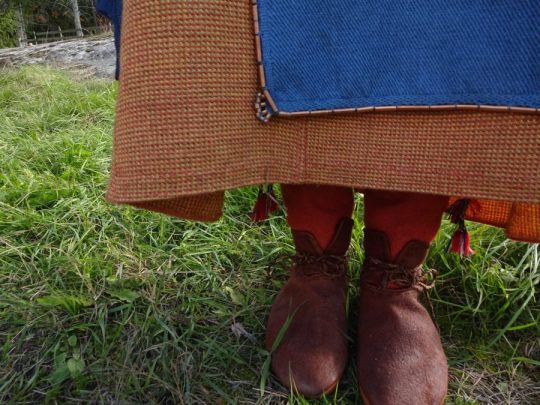
These are not necessarily mutually exclusive theories. The lacing of the shoe could have been laced up the leg and used also to secure either sock or leg wrapping, or they could have been separately secured in ankle and knee respectively.
In some graves twill fabric has been found in the leg area. It could be part of pants or for example leg wrapping, which was often made of twill. One theory about pants is that they were similar as some findings in Sweden, where fairly tight pants made of twill were secured at the hem with buttons similar to cuff studs. These kinds of cuff stud buttons are quite a common find in Finland and some have been found in men's graves close to legs.
Dress
Again there's not much findings of dresses, but a little more perhaps. It was usually from wool. The shape was either a tunic or an open coat. In Karelia there's findings of men's dress suggesting tunics thicker than women's dresses and made from sarka, a type of broadcloth. On the other hand, in Masku (Finns) they found buttons in a row on top of the torso, which suggest a coat closed with buttons. The first picture is a drawing of the grave find. Similary coak closing amounts of buttons have also been found in other places in western Finland. This suggests that Finns and probably Tavastians too wore long coats buttoned to the waist and Savonians wore tunic of Karelian influence. Below there's couple of version of what might this western Finnish men's coat dress could've looked like. The first is an imagined version of the coat based on the Masku grave finds, second is just as imagined version based on Eura (also Finns) grave finds.
Take these "reconstructions" with a strong dose of salt. These are more artistic reconstructions than scientific, since there's not enough material and too much guesswork needs to be done. And because we can see in the Masku grave drawing right here that the other deceased has a large buckle to (probably) close the shirt (to be fair, it could for a cloak too), like was typical, I find it implausible that the coat neckline would be small and round covering the buckle. If you make a decorated big buckle, I assume you want to show it. I would find a v-neckline more probable. It's also easier to make without wasting expensive fabric.


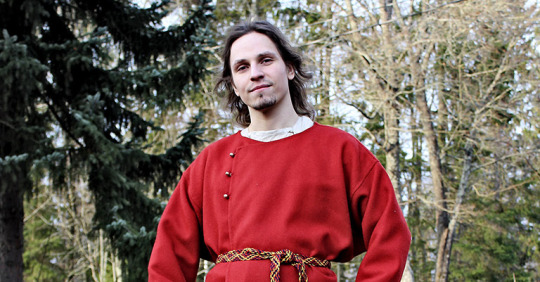
The buttons are interesting. There were what you would imagine - your typical buttons made of bronze like seen in the first artifact from Hattula (Tavastians). But then there was silver jingle bells used as buttons, found for example in both Masku and Eura graves, Eura findings pictured below.

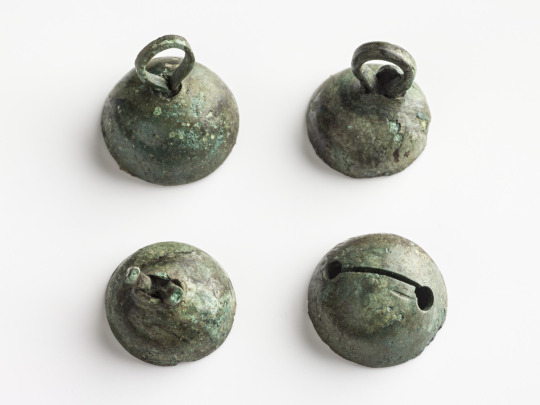
It's possible, even probable I'd say, that the hemlines of men's dresses were finished with tablet weaving patterns, like women's dresses. Also I would assume the pattern of the men's dress (and shirt) was mostly similar to the women's underdress/shirt patterns. So here's couple of different reconstruction patterns for women's dress. Different historians have made different interpretations of the patterns, so it's very much undecided what it really was like.


Belt
This is likely the most ornamental part of men's dress. They could be made out of leather or tablet woven band. And there's another east-west cultural divide here. Karelian belts were made out of leather, were usually 1,5-2,5 cm wide, decorated with iron or bronze studs and had a buckle made out of iron or bronze. These types of belts have been found in Savonia too, for example in Tuukkala grave find, which you can find very cool pictures of in this photo documentation of the dig in pages 173-175. In western Finland a "hela" belt was the common style. I don't think there's a world for hela in English. It's a sort of decorative lamella, small metallic plate (not necessarily square but often so) attached to fabric or leather with studs or sewing. Hela belt came from the Permians of Kama river, who were one of the many Finno-Ugric peoples who used to populate much of European side of Russia. Karelians lived closer to Permians, so you might think Permians would influence eastern Finland more, but my theory is that the costal Finns, who frequently joined viking crews and at least were in close contact with merchants including vikings, who would travel along the eastern route through the eastern European rivers, where they could go all the way to Kama river or at least meet traveling Permians. Here's yet another Finnish source more on the Finno-Ugric people around Kama river.
Anyway, hela belt was made of leather and filled with small decorated lamellas, often in square shape, but various other shapes too, like animal ornamentation. In this period hela belt helas were bronze. First image is a nice full set of hela belt metal pieces found in Pirkanmaa (Finns). Second is an older example, right before Viking Era, from Vaasa, costal settlement, (Finns), depicting a very Permian style. The third one is a lion hela found separately in Pälkäne (Tavastians). They are also found in Tuukkala, showing that both eastern and western cultural influences were present there at the same time.
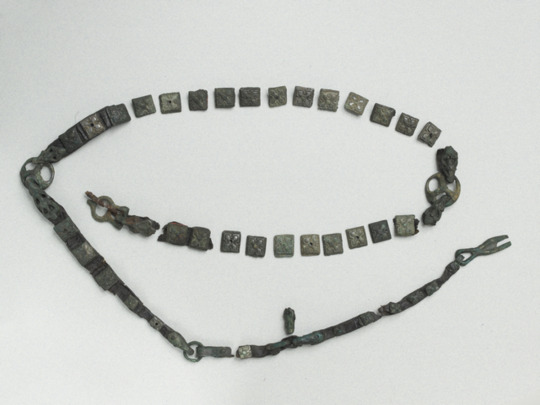
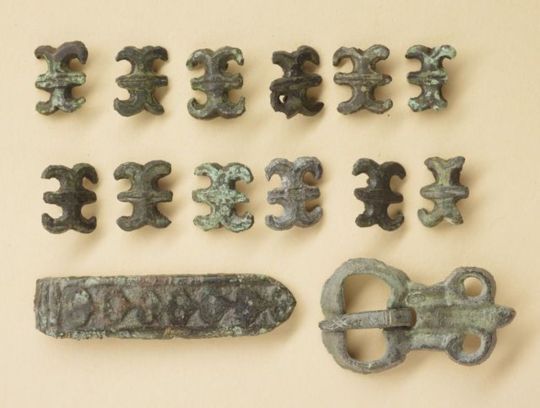

Another western Finnish belt type for men had intricate tassels decorated with bronze spirals hanging on the waist at the end of the belt. They could be made out of leather or tablet woven band. First image depicts a reconstruction of such tassel. Belts in east and west would have strap dividers to hang straps for things like purse, knife and sword. The first picture above has couple of those, but the second picture below has two more of them in more detail in the middle of the picture. These finds are from Lieto (Finns).
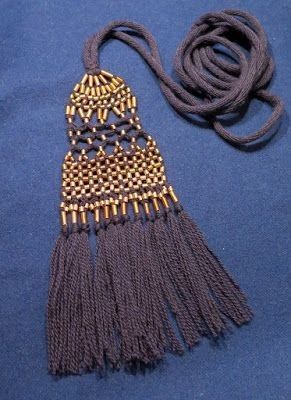
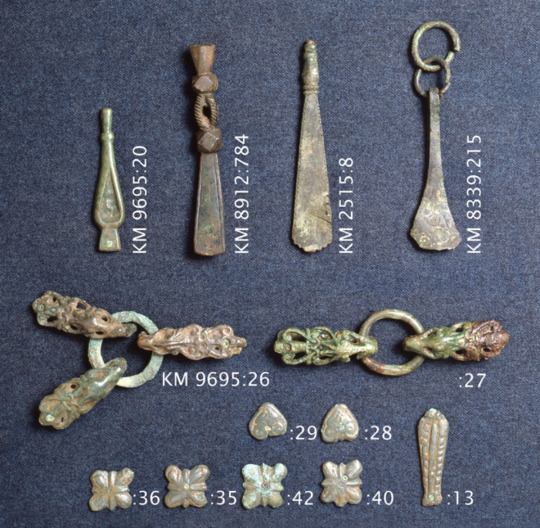
Cloak
Like women's cloak, men's cloak was woolen and either a square or trapezoid. Cloak is yet another east-west divide. In western Finland men's cloaks have embroidery with bronze spirals. They in fact appeared earlier in men's cloaks (in 900s) than in women's cloaks (1100s). They were also a little different in men's cloaks. The spirals and the patterns themselves were bigger and the fastening thread itself was also used for the pattern creation, unlike in women's dresses, where the thread was mostly covered. In eastern Finland there has been no finds of bronze decorations in men's cloaks, mostly only cloak brooches have been left of them. Unsurprisinly same applies to Karelia. This also means there's very little fabric left too. There's one exception. In Tuukkala (Savonians) they found a piece of fabric probably from men's cloak, though it could be from a men's dress too. It was striped, with possibly white or brown base and wide stripes of red, blue and yellow. So perhaps eastern Finnish cloak was not non-decorated, but the decoration was in the fabric pattern. Unfortunately it's hard to know how common fabric like that was, when so little of it is left.
Accessories
It's safe to assume men too wore some type of headwear, but none of those has survived. It probably means it was entirely made out of fabric whatever it was. Some type of hat or cap was certainly used in cold weather at the very least. Tablet woven headband was also possible option for not too cold weather.
In Tuukkala there was couple of interesting jewelry finds too. Two graves had a necklace type mostly found in Karelia. It was birchbark tape covered with nettle fabric and had square helas sewn into it. There were also more typical Finnish necklaces made of beads and bronze spirals.
Razors have also been found with men in their burials, so we can assume shaven faces or at least trimmed beards and moustaces were fashionable.
#dress history#historical fashion#historical clothing#fashion history#history#iron age dress#finnish iron age dress#finnish history#archaeology#answers#anon
232 notes
·
View notes
Text
(Edit: whoops this became a long ramble)
Met a norse pagan family at work the other day.
The couple had rune tattoos and some of seemingly Frigg and Thor. And a daughter. I dont know why but that made me very happy.
I asked if they are Norse Pagan and they said yes and they'd assumed I was too from my necklace (I always wear my mjolnir pendant.)
We rambled about it for a while and how annoying it is white supremacists steal our religious symbols, or how the religion gets twisted as a whole. How beautiful the practice is. The two own a tattoo shop. The mom has a huge Freyja tattoo on her back.
Their child is four and ofc doesn't care whatever we are talking about and wants to go back to [the activity I help them do at my work] so the conversation ends lol.
But Idk. It was very special to me. It's very special meeting other Norse Pagans-- and there's more than I thought there were, honestly. I joke that there's 3 options for every person I see with rune tattoos:
1. Doesn't really know what they mean.
2. White supremacist.
3. Norse pagan.
There's certainly overlap, but like. Pretty much that's it.
Still, there's a LOT of people who it seems Norse Paganism is, if not their religion, at least something important to them as a subject (or at least KNOWN). The amount of rune/norse tattoos I've seen is enough to quantify a lot of us. But also people commenting on my pendant. "I like your Mjolnir necklace" etc.

Maybe I'm looking into things too deeply but most people don't know what Mjolnir is. Or at least not the name. I think? I don't know. Sus.
But the fact that I, at my little random job, have run into a number of other Norse Pagans makes me happy.
It's beautiful seeing others live their lives. I think it's just that I've never seen it before, at least not in any personal experience. It's beautiful seeing this couple who runs their shop clearly inspired by and in worship to the Gods, and raising their child under those beautiful practices and prayers to Frigg and Freyja for her protection.
It makes me happy.
22 notes
·
View notes
Text

@leaswhum

Loki Jynx Lestrange is your stabbing recipient!

So, Loki's a fun character design-wise because he was inspired by a very shitty closet "cosplay" that I did like 2 and half years ago out of boredom. The tight shiny dark clothes, boob window, eyebrow scar, and slick back short hair are all because of that. When I got to drawing him I generally just wanted him to be very... sharp.
As for his face, I've always personally imagined Bellatrix (his mom) with a long ass nose so I did that but made it shorter to account for his dad (Rodolphus). His hair being brown and not black is also because of how I personally imagine Bellatrix, that being that she's a natural blonde who just dyes her hair black. Green streaks were for the sake of making him look interesting and identifiable and happened to be an option on the picrew I used to first try and conceptualize him properly 💀
Any resemblance to Tom Hiddleston was purely coincidental lmfao even though I did name the character after Laufeyson
The snake tatt on his arm was originally because he, at some point, wanted to be a Death Eater but couldn't be bc he got turned into a werewolf when he was like. 6. 5. I don't remember. He long abandons that desire and in fact eventually overcomes his biases towards muggleborns, but the snake tattoo in place of a dark mark still looked cool and would have been too much effort to get rid of. He wears gold instead of silver also bc of the whole werewolf thing, can't exactly touch silver w/o getting burnt.
He also has a boob window and generally wears clothing that shows off his chest because, and let's be clear I AM ALSO TRANS I AM PROJECTING MY OWN GENDER PRESENTATION, he's trans and he feels perfectly comfortable in the body he was born in despite wanting to be referred to with masculine pronouns and generally be seen as a man. It's kind of a middle finger to the people who want him to conform that he doesn't give a shit about their idea of what a man should look like.
HIS WAND okay his wand was fun bc I had only three things in mind: 1. It needs gold accents 2. it needs to be capable of being turned into a shiv at any moment 3. it should be kinda shaped like an L sort of. And I think I achieved all of those things! Along with adding the Norse rune version of his name (the Lestranges are pagan to some extent, not like super devout but y'know).
He pours milk before cereal purely to piss people off, he lives for stupid petty shit like that
#ask answer#ask answered#technically lol#ask game#loki lestrange#harry potter OC#hp oc#heir of sapphirius#the sacredverse#sacredverse
12 notes
·
View notes
Text
Chinese Folk Religion: Snowy edition
Recent snow storms where I live has got me thinking: is there a deity responsible for snowfall and winter in traditional Chinese religion?
You got Frau Perchta/Holle in Germanic folklore, Yuki-Ona in Japanese Shinto folk beliefs, Skadi in Norse Paganism, and Morana in Slavic mythology, but I haven't ever heard of such a figure from my elders growing up.
So for this one, I had to actually use my limited Mandarin skills to do research, along with some help from more fluent family members and friends.
It turns out there are more than one traditional winter & snow deities in Chinese folklore. The reason I personally didn't hear of any is because, again, Chinese folk religion is extremely regional. There are central major deities that are uniform but the rest all differs from region to region. Han Chinese people have always spread out across several climate zones, from tropical to sub-arctic. Understandably, Gods and Goddesses associated with weather will differ from region to region. My Chinese side of the family hailed from a region where snowfall isn't very common, and winter isn't normally extreme. But look towards regions north of the Yellow River, and it's more upstream valleys in the Han Chinese heartland, it's a different story.
Teng'Liu: The Spirit of Snow and Frost
The first deity I can find is a figure named Teng'Liu (藤六). This is a male deity associated with snow itself. The "Liu" part if his name is the Chinese character for 6. Snowflakes typically have six arms/branches regardless of pattern. In Chinese numerology, the number 6 is also a number with "extreme Yin energy" (极阴). Snow itself is a thing with a lot of Yin energy too, as it's formed from water. Those familiar with Chinese cosmology should be familiar with the element's association with the cardinal direction of North. Which, again, is attributed with Yin. Thus explains why many forms of his folk names contains the number 6.
There is a folk ritual (which thankfully hasn't been practiced in over a century), which in Northern villages they used to offer up a young girl to this snow deity as a gift to appease him. The unfortunate girl would be tied up in a sack and left to the elements in the cold.
Teng'Liu occurs often in poetic works of literature as a stand-in for "snow". A fitting example is a work from Song dynasty writer and poet Yang Wanli, where he mentions "The Azure Lady pulls along Teng'Liu, as the Sun wilts away as she shakes (him)"** The meaning is obvious, but he mentions an Azure Lady, which takes us to another deity.
Qing'nu (青女): The Azure Lady
The second deity associated with snow and winter is a Goddess called Qing'nu, or "The Azure Lady", "The Lady in Turquoise", "The Lady in Blue", depending on the translation. She seems to be much more well-attested in ancient religious texts in addition to poetry and seems to predate the emergence of Teng'liu.
Attested in Huainanzi, a text compiled around 139 BC, "...three moons into autumn, Qing'nu emerges (from her home), and makes frost and snow fall..."
She is also mentioned as having white hair in a lot of classical Chinese poetry.
In traditional Chinese folk beliefs, Qing'nu resides in the moon and is a companion/handmaiden of the Moon Goddess Chang'E (嫦娥). Every year at the end of autumn, she will emerge from the moon palace to perform her duty: to bring winter, frost, cold, and snow. She will descend upon Mount Qing'yao (青要山), where she will bathe in the waters there to purify herself. She will then start playing her seven-stranded lyre and snow and frost will fall upon the earth to cleanse the land of impurities and diseases (until they come back next summer).
BTW Mt. Qing'yao is an actual mountain in Henan Province. The mountain itself does play a rather big role in traditional beliefs and in Taoism. In fact, there is a hill adjacent to the mountain named Qing'nu's Peak (青女峰), where on the peak there stands a pillar-like rock. In local folklore they say that lone pillar looks like a slender lady, standing atop the mountains looking down upon the earth. It marks where the Goddess herself stands every year to bring winter. The locals call it "the maiden's rock" (闺女石).
Legend has it there was once a gorgeous palace at the foot of this mountain where Qing'nu would stay in temporarily during winter. This could possibly be a reference to some type of structure used as a shrine or temple. Today only the spring that flowed in the palace remain. The very spring that, according to folklore, that the Goddess herself bathes in to purify herself. Today, young ladies from around would make pilgrimage to that spring to welcome her arrival on 14th day of the ninth month. A second pilgrimage would also be made on 13th day of the third month as she is supposed to leave and return to the moon. (the dates are the dates in the Chinese lunar calendar).
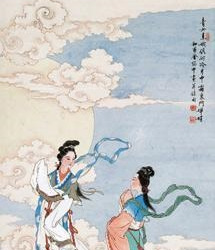
From these we can see while those deities are all associated with snow, they are seen by the people as very different. Teng'liu is very embodiment of the weather phenomenon, kind of like Jack Frost in American folklore. The fact there were rituals to appease him means that he is seen as a very unpredictable and volatile force. A spirit which has to be controlled under strict orders from a higher Celestial deity (天神): Qing'nu. Think of her as the Chinese counterpart to Frau Holle, a spirit attributed to making snow fall but not the snow itself. Or rather, think of those two like Helios and Apollo in Greco-Roman mythology. One being the sun itself and the latter being the one who pulls the sun across the sky.
This was fun, i hope all you folks who are trying to connect to their ancestral beliefs found this useful.
**translation might be off, sorry. Middle Chinese is difficult even for fluent speaker who studies old literature, plus this was Middle Chinese in it's poetic form.
#chinese folk religion#folklore#chinese folklore#history#ancestors#witchblr#witches of color#han chinese#chinese diaspora#folk taoism#chinese mythology#chinese religion#folk religion#polytheism#world religions
70 notes
·
View notes
Text

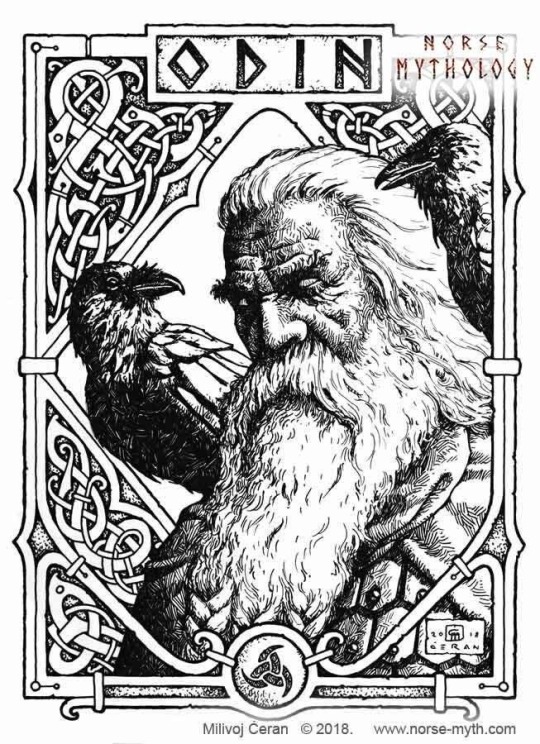
(***NO N*zis or TERFs allowed to interact with this post or my blog*** This is a post for Norse pagans or polytheists looking to work with Odin. This is all based on my own experiences working with the all father and nothing here is to be taken as a hard fact. If your practice differs from my own that is totally fine. There will be a lot of UPG and SPG)

An incomplete summary of Odin in Norse mythology.
Odin, god of war and wisdom is a key figure in the Norse myths and is involved in a lot of the stories. He is the head of the Norse gods and is called the All father, because it’s by him that all of humans were created. He is married to Frigg and together they had Baldur and Hodr. Odin also has other sons, Thor, Vali, and Vidar.
He has two ravens Huginn and Muninn, and two wolves Geri and Freki.
He only has one eye, he sacrificed his other eye by throwing it into Mimir’s well in exchange for knowledge that could better help him prevent Ragnarok.
Another famous story of his is when he hung upside down from the tree of life for nine days and nine nights to get knowledge of other worlds and to be able to know everything about the runes.
The type of magic he practices (Seiðr) was a feminine type of magic that wasn’t always looked highly on when men would participate in it. Yet our Allfather was very practiced in it.

My experience working with him: One thing to know about working with Odin going in, he will be very honest and blunt. My other deities have a habit of being softer on my feelings than I’ve heard other devotees say they’ve been with them, I’m assuming because I’m very sensitive. But Odin..? He does not care. He will stop giving advice if I tell him I don’t want to hear it. But, if I ask for advice…oh boy, am I gonna get his full opinion. He is very much a father in the way he goes about things, he cares but he wants his followers to push themselves as much as they can, learning as much as you can and always growing, never staying sedentary for too long.
I have a notebook dedicated to him that I’ve been using to work on learning the runes and that seems to be the best offering to give him in my practice right now. He never misses a chance to remind me I need to get back to learning the runes too.
I always wondered why it mattered so much to him that I learn them. Eventually he told me that it was because they really would be useful in spells, and wards and making bind runes out of them is something I’m learning to do now.
He is not the easiest deity to work with, he may even push your buttons on purpose to get you to think harder on things. I’ve noticed he’s even been rude before just to see if I’d stand up for myself and set boundaries and then he’ll explain himself after. Lots of tests trials and teachings. But man, is it worth it for the immense amount of knowledge and mentorship that he can bring. All in all, I’m glad he came to me later in my practice as I might’ve been scared off from deity work if he was the first. But, I love him to pieces and hope to work with him for a long time.

Offerings and associations of Odin
(Odin does not eat food so I’ve seen many people say not to give him food offerings, I disagree! Give him things that he can feed to Geri and Freki. He is known to still fill his plate and just give them bits over meals. So don’t hesitate to gift him any food offerings you would to any other Norse god)
-colors: gray, dark blue, black
- tree Imagery, Yggdrasil in particular
- raven Imagery, black feathers
- wolf Imagery
- clear quartz
- onyx
- blue goldstone
- amethyst
- carnelian
- the hermit tarot card
- the hanged man tarot card
- the four of cups tarot card
- the king of swords tarot card
- mead, wine, alcohol
- poetry (he writes poems!)
- mugwort scent/incense
- Ansuz rune ᚨ
- learn about the runes
- learn his myths
- learn useful and practical knowledge
- read books
- ask him for advice

There are many more ways to learn about him and get close to him. A great one is reading the Hávamál. If you meditate or do tarot or rune casting those are also great ways to contact him and get closer to him.
Signs he might be reaching out; seeing ravens more than usual or in non native areas, very windy days, rain, seeing his name often, feeling drawn to his mythology, seeing his tarot cards pop up often, you already work with one of his sons (I think he sent Thor to me first to soften my idea of the Norse gods and be a warm intro into their pantheon.)
He is a great god to work with, lots of work though. Odin is not for the weak minded, but he’s been so worth getting to know.
#norse paganism#heathenry#odin#norse deities#deity witchcraft#deity worship#deity work#Norse#norse mythology#Norse gods#paganism#Odin deity guide
160 notes
·
View notes
Text
Witchcraft update!
Kinda long so under the cut
I've been mostly focusing on reblogging political stuff to this blog but I still want to share my journey with my craft. Loki has reached out, very loudly. In a way, this has been a long time coming. We have a very long history together, rocky as it's been:
He and Aphrodite were the first Gods I reached out to. I had developed an interest in Loki between my obsession with viking vampire Eric Northman and Marvel, which led me to the actual Norse mythology. I also made it clear I knew he was different from his Marvel counterpart, just to assure him I was taking this seriously. However, after several loud hints (slipping and falling flat on my ass in the rain just before work, breaking a plate on my shift, even losing half of a cookie to my tea the night I contacted him) I got the feeling he didn't want me. I was sad at first, but respected his wish and moved on to other Gods.
Then I got my tubes tied. I came out as trans. I was hospitalized and finally put on medication after years of being afraid of it. Then, I got my name changed just two months before my top surgery. I was on my way home from my court hearing, and I thought of Loki. "Love Again" by Dua Lipa came on instantly. That was what made me realize he didn't reject me because we weren't meant to work together, but because I wasn't myself yet. Things didn't progress between us then, but still, I knew he was there.
More things changed. I got into a relationship, and opened myself to polyamory. Moved to MD to be with my now spouse. Started a soul-bearing memoir about suicidal ideation. And, finally, got into pop culture paganism, reaching out to my beloved goblin King. That was when I really started to feel like I was on the right path.
It was around this time last year that Loki finally announced himself, for real. I started having dreams about him, and guess what? It was the Marvel version I saw. A couple of my pagan friends who work with Loki say he appears to them in that form too. He was basically telling me not only was I on the right path, but I was being led back to the place I started, with him, except this time without the shame around pop culture deities. He knew I needed my goblin first, because that was the step I needed to take to unshackle myself from giving a fuck what others think. That doesn't mean Loki LIKES Marak, in fact they fucking hate each other, but they both do their best to stay civil.
Loki literally does not give a fuck which way I envision him, or if I engage with him via Marvel content or mythological content. He knows I love him either way, because basically everyone I've ever fallen in love with has had a streak of Lokean chaos. Including the goblin.
His presence started to get really loud. Here are a few signs he sent:
1. A spider moved into a geode we have in our living room right as we started talking again. Felt like I was living in a Ghibli film.
2. A dream where we were having sex while "Good Luck, Babe" by Chappell Roan played in the background. GOOD LUCK, BABE. "You're nothing more than his (the goblin king's) wife." Subtle as an eight-legged horse.
3. My spouse's missing Del Toro tarot deck showed up, after missing for MONTHS, right around the time I was looking for a way to talk to Loki properly. My spouse hadn't had much luck with it because the guidebook was obtuse as all hell, and they actually had to use a cheat sheet from another deck to supplement. No wonder Loki wanted me to use it instead.
4. Found a rune set in my favorite knickknack shop when I'd never seen one there before.
5. So I've been trying to lucid dream for like, over a year, to see my goblin. Loki not once, but twice sabotaged these efforts by sliding into my DMs instead. First time in his natural redhead state, the second time as the Marvel version. He knows I'll have him both ways.
TL;DR Loki said "no, no, no, come back when you're the unapologetic little freak I know you're meant to be. There you are! Now pay attention to me :3"
#witchcraft#paganism#Lokean#loki devotee#loki deity#pop culture paganism#pop culture witchcraft#norse loki#norse mythology#norse paganism
9 notes
·
View notes
Note
Is it true that Friday the 13th was a day of veneration to Freyja before the church started associating it with the devil?
Edit: Made one mistake in the original reply; Friday is named after Frigg, not Freyja! So this is edited to fix that.
So the thing about all of these cutesy little "did you know X has pagan origins??" memes, is that pretty much all of them are basically wrong. They tend to come about because people just kind of assume that if something doesn't have a Biblical basis, then it must be a carryover from pre-Christian paganism. People have spun all kinds of conspiracy theories out of this.
Moreover, many people have attempted to find a historical basis for the allegations made during Europe's pre-Christian witch trials, proposing that accused witches were actually cryptopagans gathering in the woods to worship some pre-Christian deity. In reality, the accusations were based on what Christians of the day imagined paganism to be like based on centuries of demonization: orgiastic, violent, and ultimately satanic; as well as a full-blown mockery of Christianity. Within the logic of the witch panic, if Christians have a sacred day of worship, then witches must also have a sacred day of worship - just evil. It's important to note here that Christians believe that Jesus was crucified on a Friday.
If we look at Wikipedia's article on the witches' sabbath, we can see that the idea of the witches' sabbath isn't extraordinarily old; in fact, it's a product of Europe's witch panic.
Also, Friday isn't named after Freyja; it's named after Frigg. And the whole claim that Freyja was worshiped on Fridays because Friday is named after her shows ignorance of the actual reason why the days are named the way they are. The whole thing actually goes back to ancient Rome. Sunday was dies Solis (day of the sun), Monday was dies Lunae (day of the moon), Tuesday was dies Martis (day of Mars), Wednesday was dies Mercurii (day of Mercury), Thursday was dies Iovis (day of Jupiter), Friday was dies Veneris (day of Venus), and Saturday was dies Saturni (day of Saturn).
The Romans, of course, were big on the idea that everybody else's gods were actually the same as their own. They associated Tyr with Mars, Odin with Mercury, and Thor with Jupiter - do you see where this is going? Friday got named after Frigg because in the Roman way of looking at things, Frigg is just the Norse version of Venus.
Finally, as far as I am aware, Freyja was never historically linked to the number thirteen, either. Every page I can find linking Freyja with the number thirteen is repeating the claim that Freyja was venerated on Fridays, and offers no explanation of why Freyja was associated with the number thirteen. If you look into myths about Freyja, you won't find her associated with thirteen of anything - and it would be very strange if you did, because the main sacred numbers in Scandinavian thinking were three and nine (three times three).
On the other hand, thirteen is an important number to Christians. Jesus plus the apostles made thirteen. The thirteen of them gathered at Passover shortly before Judas betrayed Jesus.
In conclusion, Friday the 13th has nothing to do with Freyja; this whole idea that it was historically associated with her is nothing more than a post-Christian conspiracy theory.
#freyja#friday the 13th#friday the thirteenth#history#pseudohistory#conspiracy theories#conspiracy theory#conspiracism
107 notes
·
View notes
Note
I can’t remember who reblogged that new Raphael mod so apologies if you haven’t seen it, but I was very disturbed by it. I’m talking about the “deaging” one that I assume was made by a teenager. I don’t understand how people can claim to like a character and then want to make them “younger/prettier”. All those mods, like the ones for Astarion and Gortash look awful to me. I saw that people were trying to have an interesting discussion in the comments of the post about maybe that’s how Raphael really looks since he’s immortal and could have stopped aging. But I wanted to ask them if they’ve seen a representation of Odin ever. Being immortal doesn’t necessarily mean looking like a bland pretty boy. Is this a Draco Malfoy twink thing? Do you have a better idea of what the appeal of this is, because I really don’t get it.
Interesting question! I think I know the post you are talking about. I don’t really ‘mod-shame’ (is that a term?). People can do whatever and it doesn’t affect me. That being said I do kind of agree with you, it is sad, and I think, some of it at least, might stem from a place of ageism. Maybe also the fact that some people have gotten so used to videogames and animation that they forget what actual people look like when a game more realistically portrays someone, if that even makes sense?
I also just think that some of the people liking those mods are very young themselves and might feel odd about their favorite characters looking older. Like that age where you are in denial and ashamed about liking characters who look old enough to be your parent (I remember that vividly at least. Maybe it’s just me idek). I really cannot imagine any grown-up person thinking it’s necessary to remove wrinkles on characters. Perhaps I’m just naïve but I have always suspected it’s just teens who do it. We’ve all been there.
That said, I do think there is some truth to what people are saying about him looking older on purpose! If I recall correctly, cambions stop aging around 20-30 ish and I thiiiink it’s the same for other devils? They just choose to look older to be taken more seriously. Even good ol’ Mephistopheles have like three different forms, so it’s not uncommon in the Hells to be very particular about their appearance.
I’m also coincidentally a Norse Pagan (the inclusive and reconstructionist kind, and not the n*zi-dickheads-who-likes-to-play-vikings kind, obviously) and I think Odin actually does the same thing. The Norse gods aren’t “true” immortals. They just munch on apples that prolong their lives, but they do eventually die, and they do age. Odin appears like a lot of different people, and I wouldn’t put it past him to just look old because it fits his wise, all-father persona. He is dramatic like that, much like our dear Raphie boy. (Which is completely unrelated to your point, I’m just a fucking nerd who can’t help myself when people talk about stuff I’m interested)
(Thank you for the ask <3)
26 notes
·
View notes
Note
Hi! I’m an agnostic with an interest in learning more about Norse polytheism, and I have a question about the way that the sagas and myths are interpreted.
Are the sagas (and other Norse myths) viewed as having actually happened at some point, or are they viewed more as symbolic/metaphorical, like a fable or an allegory?
Hi there! Thank you for the ask! This a topic I very much enjoy discussing, and I'll be glad to give you my thoughts on the matter.
Before I can properly explain what the sagas are, I'll determine what they aren't. They aren't to be confused with myths, such as the ones that make up nordic mythology. They are not part of that mythology for a plethora of reasons. While mythology pertains to deities we know have been worshipped as such at some point in time, the sagas are stories of human beings. More often than not, they mean to tell historical events, which represents a major difference with the myths. A saga often recounts the history of a particular dynasty, or family, and a lot of the characters who appear in them are either: 1. folk heroes, such as Wayland the Smith, who appears in the Þiðreks saga, or Sigurðr Sigmundsson, who appears in the Völsunga saga; Or 2. famous, historically attested figures, such as Erik the Red, whose story is told in the Eiríks saga rauða, or Harald Fairhair, who appears in Snorri's Haralds saga hárfagra.
This is another parrticularity which differentiates a myth and saga: the latter often brings to life real life historical figures, or even attested events. Still, these stories are steeped in folklore. They mix magic and history, and the line quickly blurs between reality and fiction. And considering that many of the sagas' authors remain unknown to this day (that is the case for the Icelanders' sagas), there is a limit to how much we can trust their writings. In fact, there is very little historical fact to be found in the sagas. However, some of the events they describe seem to hold some amout of truth! For example, it's speculated that the viking remains found in Dorset could have been the bodies of captured men who appear in the Jómsvíkinga saga. And Eirik the Red did in fact sail from Norway to Greenland and North America, making him and his crew the first Europpeans to land in the Americas. And when it comes to the stories of famous Scandinavian dynasties, the sagas serve to explain, using both fact and fiction, how this or that famous king has earned a throne.
Now, what makes these stories interesting to us as pagans? Well, as is often the case, the answer varies from one practionner to the next. To read the sagas is not a necessary part of the nordic pagan path. But to me, it helps to get to know the faith a little better. It allows us to better understand the cultural and historical context behind certain beliefs ad practices. They often showcase the very last accounts of ancient festivals, rituals, or famous temples. They are a tool of choice for many scholars, who, of course, are still forced to try and tell truth from fiction. But they're a fun read overall, and I highly recommend looking into them!
As for the myths, by which we mean the stories which compose what's called norse mythology, they are generally viewed as metaphors. They're a way for us to see our Gods come to life, and to find out some of their most prominent characteristics. The amount of credit you choose to put into mythology is entirely up to you, but I can confidently say that most pagans don't take them at face value. They're a fun way to help us imagine what the Gods might be like! For example, most agree that Týr is brave, Freyja, headstrong, and Frigg, caring. These are examples of details we can try to figure out if we read between the lines of these myths. What's most important to keep in mind, however, is the fact that many of these myths were heavily influenced by their authors. For example, Snorri, famously a Christian priest and Icelandic politician, would manipulate certain stories to better serve his political goals. It's widely accepted for example, that elements of the myths such as Angrboða and some other such lovers of the Gods were most likely invented during the 12th century, era during which a lot of the myths we know today were being compiled by priests. These changes often served to fill in the gaps left by a tradition of exclusively transmitting folklore orally. We can only speculate as to how much of the myths were truly part of pre-Christian oral tradition, which makes it even more relevant to exercise skepticism around mythology.
#ask#asks#norse paganism#norse gods#polytheism#spirituality#paganism#heathenry#deity work#deities#pagan#sagas#mythology#norse mythology
59 notes
·
View notes
Text
Introducing Rune ✨️
Hello! I'm Rune! If you saw my name as something different on my blog before I changed it, no you didn't haha
Anyways, some quick facts about me:
🦊 I'm nonbinary, (Although more along the lines of gender fluid)
🦊 I'm 24
🦊 I love languages, history, writing, tea, and have a special connection with foxes; I tend to study pretty frequently in my free-time and I also love a good ttrpg, video game, and book.
🦊 I'm Polish American but sadly the only thing passed down from my grandparents were those lovely, lovely polish recipes, and they passed long before I can ask them more about how they grew up, so you may see some content on this blog about me discovering my roots as a Polish American from Appalachia living (suffering) in the south haha
🦊 I'm also striving to learn herbalism, but not in a crunchy, conservative way (Because yes, that does need to be clarified these days it seems)
🦊 I hate bigots and I WILL stand on business if you try to come on my blog and interact with me if you're one of them. (Aka I will block you if you are anything from a neo-nazi, to a terf, to a homophobe. Do not interact with me if you're gonna hate on others for being who they are.)
🦊 And finally- I love baking and cooking, so there might be a bit of flare of that as well.
Now, onto some facts about my practice:
🦊 I am.. very heavily pagan. Specifically Norse and Hellenic, however I've recently been looking into Celtic, and Slavic Paganism
🦊 Although rn I'm more of an eclectic witch, I'm currently building my craft from the ground up with a much heavier focus on folk magic. I will be splitting content, however, across 3 blogs. This one will be more basic, lighthearted stuff, things I wanna review first, take my time with, or very introductory; @ofwoodandash which will cover more intense, darker, and more specialized topics including but not limited too: Seiðr, traditional witchcraft, Appalachian Witchcraft, Spirit Work, chthonic aspects and the like; and finally @apagansprayers which will cover things more religious in Nature, mostly as a digital prayer book and personal e-shrine to the deities I worship, as actual information may be reblogged here (To this blog you're reading this from),, I'm still.. debating how to use that blog specifically BUT that´s a general outline.
🦊 I also have almost a decades worth of experience with Tarot, Oracle, and Pendulum readings, and I'm also currently learning the Runes
With that being said, I believe that covers enough of the basics, but! If you ever have any questions about me or my practice or just wanna chat- feel free to send me an ask or a message! I'd love to chat!
Check out Rune's Tag Masterlist for a handy guide on how to navigate this blog! (Will be posted soon)
14 notes
·
View notes
Note
Hello, if it's not a bother I was hoping to get a reading for my spiritual journey. I'm sorry if I don't know how to phrase some things. For about three years now, I have been very pulled towards the beliefs of Norse paganism, and it has lead to a lot of healing and positive change in me. I feel more connected to myself and the world than I ever have. Unfortunately, I am also at conflict with other large parts of myself; even asking for this is a challenge because I really don't believe in this kind of stuff. I have always been non-religous, and have never believed in spirits or deities.
At the best of times I feel like I've done my research and taken the beliefs that I need to better myself, and at worst I feel like I'm being silly, but I always feel like I just need to let it go already because I've never taken any steps to solidify this as a part of my life. I've never been someone to have spiritual practices because these kinds of things lose meaning to me as soon as they become routine. On top of all that, I genuinely feel like there has been something trying to contact me during this journey, and I'm having the worst time trying to come to terms with that idea; I don't want to believe it but I also know that there have been too many things that just can't be coincidences. I guess I'm trying to ask if there is a step I should be taking? Something not obvious to me? Or should I just move on and push the idea of this out of my head? I guess it would also be nice to know if something has been keeping tabs on me this whole time. I just feel like I've gone through years of driving myself crazy, constantly going through cycles of wanting this and being scared of this, especially if there might be an entity involved. I don't know if I keep coming back to it just because it helped me during hard times, or if it's a feeling of being called home.
I know you asked for a reading but I felt compelled to give you some advice in general. I doubt tarot cards will help you understand this better.
Consider the perspective that you don’t always know what you’re doing. You’re not always going to know what you’re doing, ever. In fact, most people don’t always know what they’re doing. The Gods hardly know everything there is to know about what They want Themselves. You would think that, by now, every person would already know how to be spiritual because it is second nature to them yet society has made it so very clear that being spiritual is not reasonable.
Given that you’re not always going to know what you’re doing also means that it’s not going to be obvious even when it hits you in the face. Being spiritual means that you need to be aware of the fact that the world around you is much bigger than you see. You are just one person. The universe and cosmos are simply not reasonable and certainly not going to fit in one person’s singular narrative or perspective.
So, why bother? Why be spiritual if we can’t know what we’re doing? Why do anything spiritual if you can only guess the reality of things and distortion is surely going to happen because we do not live in a world that spirituality is rewarded or sensible all the time?
The act of being spiritual is also a misnomer because really, in order to be spiritual you actually need to get closer to being human. If you go back far enough, humanity’s instincts were to offer things to beings and concepts they cannot fully grasp. Humanity has always had something they would look to that is above them. They had always known that, in a way, they were being watched over and the Gods have always watched over humans.
It is normal these days to assume that these ancient humans (and, actually, even before our homo sapien ancestors walked this earth, we have evidence of various hominid species that took it upon themselves to do ritual and document it) did not know better and they had no choice but to look to the Divine because their environment put them in a position that made them vulnerable to the elements and dangers of the world so they needed the Divine’s guidance.
We assume that the Divine is just a greater terrestrial feature of this earth that qualifies as “bigger than us” and so therefore we called them “Gods.” Like Thor being the cause of thunder or Zeus, lightning. This is an inherently modern concept. We cannot possibly boil down the nature of the Gods into specific categories and so when science came around and could not explain them, they paired the Gods with naturally occurring terrestrial phenomenon and that was it.
However, in order to fully examine the cause of the Gods and early humans, we’d need to think critically of ourselves. What, in our nature, are we missing enough to want to believe in something, somewhere? Even the most atheistic of people believe in something they cannot measure and would, in fact, create a religion themselves around logic and practice proselytizing to each other the wonders of science and factual evidence so that everyone could see how smart they are.
We’d want to hope that we are inherently fulfilled and complete without some external force that is uncertain and ever-changing. We’d want to believe that this external force could easily exist without us. And we could and They do. However, when humans cross paths with these external forces and the Divine mingle with humans, we have evidence of great progress. I think of the Mayan architecture and the Greek and Roman empires before Christianity infiltrated or perhaps even ancient Egypt, Japan, and India. Our version of world history does not cast a favorable eye on the progression made by societies who have documented ancient polytheist cultures because history was written by the victor and notice how everything gets easier to understand the moment the predominant religions of the world today came around (except Hindu and Shinto, but even they have been mildly affected by Abrahamic faiths that historians classified as just a change in perspective).
You see that religion over time - at least, organized religion - becomes less about encouraging people to look within themselves for their inner guidance and more about what they feel is correct morally. Which then leads to problems because moral compasses are easy to target when you seek to control the masses.
So, to wrap up this whole argument about faith, consider that having a Divine source call to you is actually a naturally occurring human experience. It is not a moral argument about how right you are or a black and white answer as to how logical it is. Associating meaning with logic is not how we are going to progress as a society. It has led to faith in the Divine being associated with a book or a person who they insist existed all that time ago (and even when they find evidence that would counter that argument, they develop whole museums as to why they are wrong).
We also have cast the polytheistic practices of the early ages as “silly” and “strange.” We feel that they aren’t evolved enough to see the “true meaning of the world” that we can easily describe as logical or sensical.
However, humans have always been logical creatures. We do what we can to survive. We adapt to environments that are not conducive to our inhabiting it but do it anyway. We are flexible and strong and we have behaviors that the Gods are envious of. The Gods have always been there in the crevices of the history of ourselves, and yet, we have always shoved them away and written off their existence as logical parts of ourselves.
The Gods have been apart of human lives ever since we could first be aware of ourselves as “people.” Every breath we have taken and every living person has always had a Divine attachment simply because we, ourselves, are Divine and They are a part of us. We have just ignored that side of ourselves because predominant religions have cast the Divine as Something Else.
That was a very long-winded explanation but I felt as though more people possibly needed to hear it. All of this to say that, you’re going to be reached out to. The more you look deeper into yourself and the purpose as for why you are doing this, things stop becoming logical in the way that the material world would like them to be and becoming more logical in the way that the patterns that have helped you get to this point were all focused on getting you to believe that there is more going on here than what we can see at face value.
If you hang every single reason on it being “logical” and your logic solely depends on what you can see, it will never be real. If your logic depends on your experience (which, by the way, is just as real as the material), then you’re going to find that a lot more is possible and can possibly happen. You become more than just a human being getting through a day to day existence stuck on this giant rock in space.
My best and most simplistic advice to you would be to let go and see what happens. You’re not going to lose anything by trying and you’re not going to gain anything by not. If your purpose in life is solely based in the material, you’re never going to get past the point you are now so why avoid trying? Isn’t it worth the progress?
As for whether or not something is reaching out to you, my gut feeling is Loki. Most people don’t know this about Himself but He is the Divine doorway. He gave us each this part of ourselves that long for the Divine. He is a trickster, yes, but consider that in order to inspire you to look beyond the material, you would need to look outside of the box you were born into and see outside of yourself. That is what tricksters are there for and that is likely what He is intending on helping you do.
I hope you found this helpful and if you need to talk, my DMs are open.
#deity work#paganblr#polytheism#paganism#norse pagan#mysticism#deity worship#lokean#pagan blog#norse paganism#ask
6 notes
·
View notes
Text
Poetic Edda vs. Prose Edda
What are they? What's the difference? And why are they important?
Simply put, the Eddas are collections of stories about Norse mythology. They are the closest thing we have to a primary source for the tales that ancient Scandinavians told. Since the people who originally told these stories passed them down orally, these texts are not 100% accurate. However, as with everything, they are based on truth. Thus, we must look at them with a critical eye.
There are a couple of important differences when looking at the Eddas. The Poetic Edda draws from the Codex Regius and has several versions. The text tells the tales of the Norse gods and heroes, and the stories themselves may date back to the 8th century. However, the Codex was written in the 13th century. The author of the Codex is unknown, and some people believe that it was put together by several people. There are several translations available today.
The Prose Edda, on the other hand, was complied by, or possibly written by, a 13th century scholar known as Snorri Sturluson.
It is important to note that these texts were written down after the Chirstanization of the area. Therefore, there is probably a lot of bias in these tales.
These texts, along with the Sagas, are the best known texts for Norse mythology. This is why most modern Norse Pagans and Heathens read, or want to read, these texts.
Our thoughts on them
We are currently reading (and annotating) a pdf of the Poetic Edda. After that, we will move on to the Prose Edda. We have chosen the Jackson Crawford translation.
We are very excited to dive deeper into these texts! We always keep in mind the potential biases present, and we hope to report back to yall with some insight after reading!
If we made any mistakes, please let us know! We try to research and fact-check as much as possible, but we are human.
#norse pagan#paganism#pagan#pagan witch#witch#witchcraft#heathen#heathenry#norse heathen#norse mythology#norse gods#eddas#poetic edda#prose edda#Snorri Sturluson#history
8 notes
·
View notes